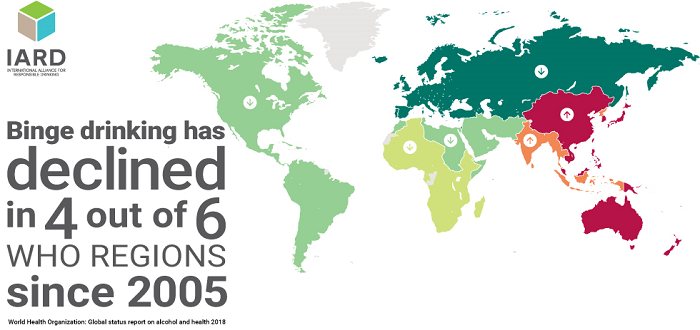
On 24 October, WHO opened a web-based consultation on a discussion paper on the implementation of the WHO Global Strategy to reduce the harmful use of alcohol since its endorsement, and the way forward for said strategy. The web-based consultation is open to Member States, UN organisations and other international organisations, and non-State actors. We will of course provide our (public) contribution to the consultation by 4 November.
The consultation offers the opportunity to reflect on the fact that since 2006, when the EU Alcohol Strategy was adopted, and 2010, when the Global Alcohol Strategy was enacted, we have seen European consumers “drinking less but drinking better”, coupled with a marked decline in alcohol-related harm.
European consumers tend to trade up when purchasing spirits with a growing demand for distinct and premium products. As a result, the volume of spirit drinks sold in the EU is declining but the average value of spirits sold has increased consistently.
In terms of risksy drinking behaviour, we have seen binge drinking declining by more than 25% between 2005 and 2016 (worldwide trend – IARD report) . The same goes for underage drinking and drink-driving which are additional precise indicators to measure alcohol-related harm. For underage drinking, the latest data available showed a 24% decline since 2003 in students reporting alcohol consumption in the last 30 days. Both the prevalence and the frequency of drinking and binge drinking were declining with 86% of European students reporting “never being drunk” in the last 30 days (a 23% decline in the level of intoxication since 2003).The frequency of heavy episodic drinking decreased by 28% since it peaked in 2007 (18% in 2007 down to 13% in 2015). These positive trends were observed among both young women and young men. We have reasons to believe that these positive trends will be confirmed by the next ESPAD survey to be published in 2020.
In 95% of countries where we have data, drink-driving fatalities are down. Estonia saw an 89% decline in fatalities from 2006 to 2016 while over the same period Bulgaria saw an 83% decline, UK saw a 64% decline and Germany saw a 62%. It is encouraging to see that the initiatives our sector has pioneered, such as designated driver campaigns, are showing their worth.
To conclude, drink-driving is down, youth drinking is down and binge drinking is down. Europeans are enjoying alcohol more and more responsibly. We hope this will be among the main conclusions of the WHO consultation on the effectiveness of the strategy. In terms of way forward, we need to bring the private sector together with governments and NGOs if we want to continue this success. In fact, in Europe, we recently called for the relaunch of the EU Alcohol and Health Forum (EAHF) and it’s clearer now again that it is essential if we want to keep advancing these positive trends.